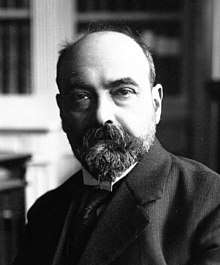Théodore Reinach
Théodore Reinach (3 July 1860 – 28 October 1928) was a French archaeologist, mathematician, lawyer, papyrologist, philologist, epigrapher, historian, numismatist, musicologist, professor, and politician.
Théodore Reinach | |
|---|---|
 Reinach in 1913 | |
| Born | 3 July 1860 |
| Died | 28 October 1928 (aged 68) |
| Education | Lycée Condorcet, Ecole des Hautes Etudes, Ecole des Sciences Politiques |
| Occupation | Archaeologist, mathematician, lawyer, papyrologist philologist, epigrapher, historian, numismatist, musicologist, professor, politician |
| Political party | Bloc des gauches |
| Board member of | Académie des Inscriptions et Belles-Lettres |
| Spouse(s) | 1) Charlotte Marie Evelyne Hirsch (1863–1889) 2) Fanny Thérèse Kann (1870–1917) |
| Children | By Charoltte: Hélène, Gabrielle By Fanny: Julien, Léon, Paul, Olivier |
| Parent(s) | Hermann-Joseph Reinach and Julie Büding |
| Relatives | Siblings: Joseph, Salomon |
| Awards | Legion of Honor |
Academic career
Educated at the Lycée Condorcet, Ecole des Hautes Etudes, Ecole des Sciences Politiques, Reinach had a brilliant career as a scholar and was called to the Parisian bar where he practised from 1881 to 1886 but eventually devoted himself to the study of numismatics. He became Chair in ancient numismatics at the Collège de France and was a director of various journals. In 1916, he was awarded the medal of the Royal Numismatic Society[1] and in 1917, during World War I, he worked on assignment in the United States.
He wrote important works on the ancient kingdoms of Asia Minor–Trois royaumes de l'Asie Mineure, Cappadoce, Bithynie, Pont (1888), Mithridate Eupator (1890);[2] also a critical edition and translation with Henri Weil of Plutarch's Treatise on Music; and an Histoire des Israélites depuis la ruine de leur indépendance nationale jusqu'à nos jours (2nd ed., 1901).
From 1888 to 1897 Théodore Reinach edited the Revue des études grecques.[3]
He received an honorary Doctorate of Letters (D.Litt.) from the University of Dublin in June 1902.[4]
Family and Villa Kerylos
In 1886, Théodore Reinach married Charlotte Marie Evelyne Hirsch. They had two daughters but she died at age twenty-six in 1889. Théodore Reinach married a second time in 1891 to Fanny Kann, a daughter of Maximilien Kann and Betty Ephrussi.[5] They made their home in a chateau at La Motte-Servolex in the Savoie department in southeastern France. As a resident there, Théodore Reinach was elected to the Chamber of Deputies of France as a member of the Bloc des gauches, serving from 1906–1914.
The Reinachs spent time on the French Riviera and in 1902 hired the architect Emmanuel Pontremoli to design a villa at Beaulieu-sur-Mer. Completed in 1908 the Greek-style property was named Villa Kerylos.
Fanny Reinach died in 1917 and Theodore in 1928. He was a member of the Institut de France and on his death he bequeathed the Villa Kerylos to the Institut.
Théodore's son, Léon (1893–1943), became the keeper of the archives at Villa Kerylos. Léon Reinach was married to Béatrice de Camondo with whom he had two children. Following the German occupation of France during World War II the Villa was seized by the Nazis and Léon and Béatrice Reinach and their two children were sent to Auschwitz concentration camp where they were murdered.
After the War, other of the Reinach children and grandchildren continued to live there until 1967. Today, the Villa Kerylos is a museum open to the public.
Fanny Reinach's mother was a member of the Ephrussi family whose cousin Maurice was married to Béatrice de Rothschild. Inspired by the beauty of the Reinach's Villa Grecque Kérylos and the area, nearby they built Villa Ephrussi de Rothschild.[6]
References
- http://numismatics.org.uk/medals-honorary-fellowship-prizes/the-societys-medal/
- Tilley, Arthur (October 1892). "Review of Mithridate Eupator by Théodore Reinach". The English Historical Review. 7: 744–746.
- Archived 2004-08-07 at the Wayback Machine
- "University intelligence". The Times (36783). London. 2 June 1902. p. 9.
- "Family tree of Betty Ephrussi". Geneanet. Retrieved 2018-08-07.
- "Archived copy". Archived from the original on 2008-11-15. Retrieved 2008-11-15.CS1 maint: archived copy as title (link)
Sources

- Théodore Reinach at the Jewish Encyclopedia.com